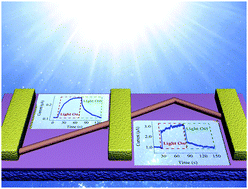Geometry-induced high performance ultraviolet photodetectors in kinked SnO2 nanowires†
Abstract
SnO2 nanowires have been widely utilized in photodetectors due to their large surface to volume ratio and semiconducting characteristics. In general, SnO2-nanowire-based photodetectors exhibit high photocurrent but a slow response speed. Here we explored the important role of geometry in nanowire-based photodetectors, as exemplified by the study of the UV photodetector fabricated from a kinked single-crystal SnO2 nanowire, in which two kinds of photodetectors, based on the straight and kinked SnO2 nanowire, respectively, have been fabricated on the same SnO2 nanowire for comparison. We found that both the photocurrent and response time of the SnO2 nanowire were improved greatly by the kinked structure; the photoresponsivity and external quantum efficiency (EQE) are measured to be ultrahigh as 1.2 × 107 A W−1 and 6.0 × 109%, respectively. Moreover, the photoresponse time exhibits a hundred times improvement, compared with the straight nanowire case. Such an improvement was attributed to the enhancement effect of the kinked structure to the local electric field, which benefits the electron–hole separation efficiency and the transmit time of carrier, thus improving both the photocurrent and response time of the SnO2 nanowire. As the enhancement of the photodetector results from geometry exclusively, this simple strategy is promising to be extended to the applications of other low dimensional materials.


 Please wait while we load your content...
Please wait while we load your content...